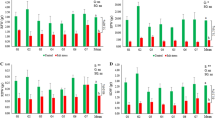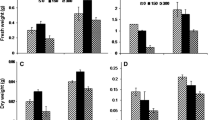Abstract
Soil salinity is a significant international environmental problem and severely affects the yield of cereal crops due to numerous effects on plant–water relations, ion homeostasis and salt toxicity. This work assessed the salt tolerance levels of 16 barley varieties by key physiological and molecular tests. Seedlings were exposed to acute salinity stress and their physiological responses including relative water content, levels of the stress hormone abscisic acid (ABA) and Na+/K+ ratio were compared. A significant variation was noted amongst the varieties, with Calmariout, Hindmarsh and Mundah identified as tolerant varieties and Franklin as the most sensitive variety. Further, the differential expression of key genes in the ABA-regulated stress response pathway, i.e., pyrabactin resistance (PYR)/PYR-Like (PYL)/regulatory components of ABA receptors (RCAR), protein phosphatase 2C (PP2C), sucrose non-fermenting 1-related kinase (SnRK2) and specific ABC transporters, was analysed by quantitative real-time PCR of leaf RNA. The PP2CA and ABC transporters were up-regulated while the PYR/PYL/RCARs and SnRK2s were down-regulated under salt stress. Importantly, tolerance ranking by gene expression closely correlated that by physiological indices. Thus expression analysis of the ABA pathway may be used for rapid identification of potentially salt-tolerant barley varieties before undertaking physiological studies. The outcomes are relevant for varietal selection and comparing the alleles for genetics of tolerance.






Similar content being viewed by others
Abbreviations
- ABA:
-
Abscisic acid
- FC:
-
Fold change
- PP2C:
-
Protein phosphatase 2C
- qRT-PCR:
-
Quantitative real-time polymerase chain reaction(s)
- PYR:
-
Pyrabactin resistance
- PYL:
-
PYR-Like
- RCAR:
-
Regulatory components of ABA receptors
- SnRK2:
-
Sucrose non-fermenting 1-related kinase 2
References
Adem GD, Roy SJ, Zhou M, Bowman JP, Shabala S (2014) Evaluating contribution of ionic, osmotic and oxidative stress components towards salinity tolerance in barley. BMC Plant Biol 14:113–125
Ahmed IM, Dai H, Zheng W, Cao F, Zhang G, Sun D, Wu F (2013) Genotypic differences in physiological characteristics in the tolerance to drought and salinity combined stress between Tibetan wild and cultivated barley. Plant Physiol Biochem 63:49–60
Ashraf M (2004) Some important physiological selection criteria for salt tolerance in plants. Flora Rev 199:361–376
Barley Australia: Barley (2014) http://www.barleyaustralia.com.au/industry-information. Accessed May 2014
Chen Z, Newman I, Zhou M, Mendham N, Zhang G, Shabala S (2005) Screening plants for salt tolerance by measuring K+ flux: a case study for barley. Plant Cell Environ 28:1230–1246
Chen Z, Zhou M, Newman I, Mendham NJ, Zhang G, Shabala S (2007) Potassium and sodium relations in salinised barley tissues as a basis of differential salt tolerance. Funct Plant Biol 34:150–162
Cuin TA, Zhou M, Parsons D, Shabala S (2011) Genetic behaviour of physiological traits conferring cytosolic K+/Na+ homeostasis in wheat. Plant Biol 14:438–446
Department of Environment and Primary Industries (DEPI) Victorian Winter Crop Summary (2011) http://www.grdc.com.au/~/…/B92E5B829E21494F83D966AF541747CC.pdf. Accessed May 2014
Fukao T, Yeung E, Serres JB (2011) The submergence tolerance regulator SUBA mediates crosstalk between submergence and drought tolerance in rice. Plant Cell 23:412–427
Garstang JR, Spink HH, Suleimenov M, Schillinger WF, Mckenzie RH, Tanake DL, Ceccarelli S, Grando S, Paynter BH, Fettell NA (2011) Cultural practises: focus on major barley-producing regions. In: Ullrich SE (ed) Barley: production, improvement, and uses, 10th edn. Wiley, New York, pp 221–281
Jain D, Chattopadhyay D (2010) Analysis of gene expression in response to water deficit of chickpea (Cicer arietinum L.) varieties differing in drought tolerance. Plant Biol 10:24–27
Jia W, Wang Y, Shuquiu Z, Zhang J (2002) Salt stress induced ABA accumulation is more sensitively triggered in roots than in shoots. J Exp Bot 53:2201–2206
Kausar A, Ashraf YM, Ali I, Niaz M, Abbass Q (2012) Evaluation of Sorghum varieties/lines for salt tolerance using physiological indices as screening tool. Pak J Bot 44:47–52
Khakwani AA, Dennett MD, Munir M (2011) Drought tolerance screening of wheat varieties by inducing water stress conditions. Songklanakarin J Sci Technol 33:135–142
Ludwikow A, Skowronska DB, Szczepaniak M, Belter N, Dominiak E, Sadowski J (2013) Expression profiles and genomic organisation of group A protein phosphatase 2C genes in Brassica oleracea. Ann Appl Biol 163:124–134
Matin MA, Brown JH, Ferguson H (1989) Leaf water potential, relative water content and diffusive resistance as screening techniques for drought tolerance in barley. Agron J 81:100–105
Moons A, Bauw G, Prinsen E, Montagu MV, Straeten VD (1995) Molecular and physiological response to abscisic acid and salts in roots of salt sensitive and salt tolerant indica rice varieties. Plant Physiol 107:177–186
Munns R, Schachtman DP, Condon AG (1995) The significance of a two-phase growth response to salinity in wheat and barley. Aust J Plant Physiol 22:561–569
Munns R, James RA, Sirault XRR, Furbank RT, Jones HG (2010) New phenotyping methods for screening wheat and barley for beneficial responses to water deficit. J Exp Bot 61:3499–3507
Nieves M, Nieves-Cordones M, Poorter H, Simon MD (2011) Leaf nitrogen productivity is the major factor behind the growth reduction induced by long-term salt stress. Tree Physiol 31:92–101
Palma F, Lopez-Gomez M, Tejera NA, Lluch C (2014) Involvement of abscisic acid in the response of Medicago sativa plants in symbiosis with Sinorhizobium meliloti to salinity. Plant Sci 223:16–24
Popova LP, Tsonko TD, Lazova GN, Stoinova ZG (1996) Drought and ABA induced changes in photosynthesis of barley plants. Physiol Plant 96:623–629
Rengasamy P (2010) Soil processes affecting production in salt-affected soils. Funct Plant Biol 37:613–620
Seki M, Narusaka M, Ishida J, Nanjo T, Fujita M, Oono Y, Kamiya A, Nakajima M, Enju A, Sakurai T, Satou M, Akiyama K, Taji T, Yamaguchi-Shinozaki K, Carninci P, Kawai J, Hayashizaki Y, Shinozaki K (2002) Monitoring the expression profiles of 7000 Arabidopsis genes under drought, cold and high-salinity stresses using a full-length cDNA microarray. Plant J 31:279–292
Shabala S, Pottosin I (2014) Regulation of potassium transport in plants under hostile conditions: implications for abiotic and biotic stress tolerance. Physiol Plant 151:257–279
Sinclair T, Ludlo M (1985) Who taught plants thermodynamics? The unfulfilled potential of plant water potential. Aust J Plant Physiol 12:213–217
Suprunova T, Krugman T, Fahima T, Chen G, Shams I, Korol A, Nevo E (2004) Differential expression of dehydrin genes in wild barley, Hordeum spontaneum, associated with resistance to water deficit. Plant, Cell Environ 27:1297–1308
Turner NC (1981) Techniques and experimental approaches for the measurement of plant water status. Plant Soil 58:339–366
Umezawa T, Nakashima K, Miyakawa T, Kuromori T, Tanokura M, Shinozaki K, Shinozaki KY (2010) Molecular basis of the core regulatory network in ABA responses: sensing, signalling and transport. Plant Cell Physiol 51:1821–1839
Walia H, Wilson C, Condamine P, Ismail AM, Xu J, Cui X, Close TJ (2007) Array-based genotyping and expression analysis of barley cv. Maythorpe and golden promise. BMC Genom 8:87–101
Watkinson JI, Sioson AA, Vasquez-Robinet C, Shukla M, Kumar D, Ellis M, Heath LS, Ramakrishnan N, Chevone B, Watson LT, Van ZL, Egertsdotter U, Sederoff RR, Grene R (2003) Photosynthetic acclimation is reflected in specific patterns of gene expression in drought-stressed Loblolly Pine. Plant Physiol 133:1702–1716
Wiebe GA, Reid DA (1961) Classification of barley varieties. In: Weibe GA, Reid DA (eds) Classification of barley varieties grown in United States and Canada in 1958. United States Department of Agriculture Press, Washington DC, pp 69–217
Wild A (2003) Soils, land and food: managing the land during the twenty-first century. Ann Bot Lond 93:785–786
Xue T, Wang D, Zhang S, Ehlting J, Ni F, Jakab S, Zheng C, Zhong Y (2009) Genome wide and expression analysis of protein phosphatase 2C in rice and Arabidopsis. Genomics 9:550–570
Yang J, Zhang J, Wang Z, Zhu Q, Wang W (2001) Hormonal changes in the grains of rice subjected to water stress during grain filling. Plant Physiol 127:315–323
Zhou J, Wang X, Jiao Y, Qin Y, Liu X, He K, Chen C, Ma L, Wang J, Xiong L, Zhang Q, Fan L, Deng WX (2007) Global genome expression analysis of rice in response to drought and high salinity stresses in shoot, flag leaf and panicle. Plant Mol Biol 63:591–608
Zhou MX, Li HB, Chen ZH, Mendham NJ (2008) Combining ability of barley flour pasting properties. J Cereal Sci 48:789–793
Ziemann M, Kamboj A, Hove RM, Loveridge S, El-Osta A, Bhave M (2013) Analysis of the barley leaf transcriptome under salinity stress using mRNA-Seq. Acta Physiol Plant 35:1915–1924
Author information
Authors and Affiliations
Corresponding author
Additional information
Communicated by M. Prasad.
Electronic supplementary material
Below is the link to the electronic supplementary material.
Rights and permissions
About this article
Cite this article
Kamboj, A., Ziemann, M. & Bhave, M. Identification of salt-tolerant barley varieties by a consolidated physiological and molecular approach. Acta Physiol Plant 37, 1716 (2015). https://doi.org/10.1007/s11738-014-1716-4
Received:
Revised:
Accepted:
Published:
DOI: https://doi.org/10.1007/s11738-014-1716-4




